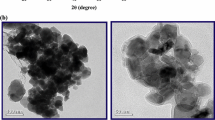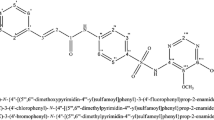Abstract
The interaction between copper (II) 2-oxo-propionic acid salicyloyl hydrazone (CuIIL) and bovine serum albumin (BSA) under physiological conditions was investigated by the methods of fluorescence spectroscopy, UV-Vis absorption, and circular dichroism spectroscopy. Fluorescence data showed that the fluorescence quenching of BSA by CuIIL was the result of the formation of the BSA–CuIIL complex. The apparent binding constants (K a) between CuIIL and BSA at four different temperatures were obtained according to the modified Stern–Volmer equation. The thermodynamic parameters, enthalpy change (ΔH) and entropy change (ΔS), for the reaction were calculated to be −80.79 kJ mol−1 and −175.48 J mol−1 K−1 according to van’t Hoff equation. The results indicated that van der Waals force and hydrogen bonds were the dominant intermolecular force in stabilizing the complex. The binding distance (r) between CuIIL and the tryptophan residue of BSA was obtained to be 4.1 nm according to Förster’s nonradioactive energy transfer theory. The conformational investigation showed that the application of CuIIL increased the hydrophobicity of amino acid residues and decreased the α-helical content of BSA (from 62.71% to 37.31%), which confirmed some microenvironmental and conformational changes of BSA molecules.









Similar content being viewed by others
References
Zsila F, Bikadi Z, Simonyi M (2003) Probing the binding of the flavonoid quercetin to human serum albumin by circular dichroism, electronic absorption spectroscopy and molecular modelling methods. Biochem Pharmacol 65:447–456
Zhang YZ, Zhou B, Liu YX, Zhou CX, Ding XL, Liu Y (2008) Fluorescence study on the interaction of bovine serum albumin with P-Aminoazobenzene. J Fluoresc 18:109–118
Shang L, Jiang X, Dong SJ (2006) In vitro study on the binding of neutral red to bovine serum albumin by molecular spectroscopy. J Photochem Photobiol A Chem 184:93–97
Company R, Serafim A, Cosson RP, Fiala-Médioni A, Camus L, Colaço A (2008) Antioxidant biochemical responses to long-term copper exposure in bathymodiolus azoricus from Menez–Gwen hydrothermal vent. Sci Total Environ 389:407–417
Takayama F, Egashira T, Yamanaka Y (2001) Singlet oxygen generation from phosphatidylcholine hydroperoxide in the presence of copper. Life Sci 68:1807–1815
Li Y, Trush MA, Yager JD (1994) DNA damage caused by reactive oxygen species originating from a copper-dependent oxidation of the 2-hydroxy catechol of estradiol. Carcinogenesis 15:1421–1427
Katyal M, Dutt Y (1975) Analytical applications of hydrazones. Talanta 22:151–166
He SY, Cao WK, Yang R, Zhao JS, Shi QZ, Wang ZM, Yan CH (2003) Crystal structure and biological activity of copper (II) complex with two aqua and 2-oxo-propionic acid salicyloyl hydrazone. Chin J Inorg Chem 19:699–704
Lu ZX, Cui T, Shi QL (1987) Applications of circular dichroism and optical rotatory dispersion in molecular biology, 1st edn. Science, Beijing, pp 79–82
Hu YJ, Liu Y, Shen XS, Fang XY, Qu SS (2005) Studies on the interaction between 1-hexylcarbamoyl-5-fluorouracil and bovine serum albumin. J Mol Struct 738:143–147
Gelamo EL, Silva CHTP, Imasato H, Tabak M (2002) Interaction of bovine and human serum albumins with ionic surfactants: spectroscopy and modeling. Biochim Biophys Acta 1594:84–99
Lakowicz JR, Weber G (1973) Quenching of fluorescence by oxygen, probe for structural fluctuations in macromolecules. Biochemistry 12:4161–4170
Zhou N, Liang YZ, Wang P (2007) b-Glycyrrhetinic acid interaction with bovine serum albumin. J Photochem Photobiol A Chem 185:271–276
Zhang YZ, Zhang XP, Hou HN, Dai J, Liu Y (2008) Study on the interaction between Cu(phen)3 2+ and bovine serum albumin by spectroscopic methods. Biol Trace Elem Res 121:276–287
Zhang YZ, Dai J, Zhang XP, Yang X, Liu Y (2008) Studies of the interaction between Sudan I and bovine serum albumin by spectroscopic methods. J Mol Struct (in press), DOI 10.1016/j.molstruc.2007.11.043
Lehrer S (1971) Solute perturbation of protein fluorescence. Quenching of the tryptophyl fluorescence of model compounds and of lysozyme by iodide ion. Biochemistry 10:3254–3263
Hu YJ, Liu Y, Hou AX, Zhao RM, Qu XS, Qu SS (2004) Studies on the interaction between rare-earth salts of heteropoly EuHSiMo10W2O40 25H2O and bovine serum albumin. Acta Chim Sin 62:1519–1523
Sulkowska A (2002) Interaction of drugs with bovine and human serum albumin. J Mol Struct 614:227–232
Wang YQ, Zhang HM, Zhang GC, Tao WH, Fei ZH, Liu ZT (2007) Spectroscopic studies on the interaction between silicotungstic acid and bovine serum albumin. J Pharm Biomed Anal 43:1869–1875
Leckband D (2000) Measuring the forces that control protein interactions. Annu Rev Biophys Biomol Struct 29:1–26
Ross PD, Subramanian S (1981) Thermodynamics of protein association reactions: forces contributing to stability. Biochemisry 20:3096–3102
Maiti TK, Ghosh KS, Samanta A, Dasgupta S (2008) The interaction of silibinin with human serum albumin: A spectroscopic investigation. J Photochem Photobiol A Chem 194:297–307
Förster (1965) Delocalized excitation and excitation transfer. In: Sinanoglu O (ed) Modern quantum chemistry. vol. 3. Academic, New York, p 93–137
Sklar LA, Hudson BS, Simoni RD (1977) Conjugated polyene fatty acids as fluorescent probes: synthetic phospholipid membrane studies. Biochemistry 16:819–828
Mahammed A, Gray HB, Weaver JJ, Sorasaenee K, Gross Z (2004) Amphiphilic corroles bind tightly to human serum albumin. Bioconjug Chem 15:738–746
Horrocks WD, Collier WE (1981) Lanthanide ion luminescence probes. Measurement of distance between intrinsic protein fluorophores and bound metal ions: quantitation of energy transfer between tryptophan and terbium(III) or europium(III) in the calcium-binding protein parvalbumin. J Am Chem Soc 103:2856–2862
Li DJ, Zhu JF, Jin J, Yao XJ (2007) Studies on the binding of nevadensin to human serum albumin by molecular spectroscopy and modeling. J Mol Struct 846:34–41
Hu YJ, Liu Y, Pi ZB, Qu SS (2005) Interaction of cromolyn sodium with human serum albumin: a fluorescence quenching study. Bioorg Med Chem 13:6609–6614
Zhang G, Que Q, Pan J, Guo J (2008) Study of the interaction between icariin and human serum albumin by fluorescence spectroscopy. J Mol Struct (in press), DOI 10.1016/j.molstruc.2007.09.002
Hu YJ, Liu Y, Jiang W, Zhao RM, Qu SS (2005) Fluorometric investigation of the interaction of bovine serum albumin with surfactants and 6-mercaptopurine. J Photochem Photobiol B Biol 80:235–242
Liu JQ, Tian JN, Tian X (2004) Interaction of isofraxidin with human serum albumin. Bioorg Med Chem 12:469–474
Cui FT, Fan J, Hu ZD (2004) Interactions between 1-benzoyl-4-p-chlorophenyl thiosemicarbazide and serum albumin: investigation by fluorescence spectroscopy. Bioorg Med Chem 12:151–157
Tian JN, Liu JQ, Hu ZD, Chen XG (2005) Interaction of wogonin with bovine serum albumin. Bioorg Med Chem 13:4124–4129
Acknowledgments
We gratefully acknowledge the financial support of National Natural Science Foundation of China (Grant nos. 30570015, 20621502), Natural Science Foundation of Hubei Province (2005ABC002), and the Research Foundation of Chinese Ministry of Education (no. [2006]8-IRT0543).
Author information
Authors and Affiliations
Corresponding author
Rights and permissions
About this article
Cite this article
Mei, P., Zhang, YZ., Zhang, XP. et al. Spectroscopic Investigation of the Interaction Between Copper (II) 2-oxo-propionic Acid Salicyloyl Hydrazone Complex and Bovine Serum Albumin. Biol Trace Elem Res 124, 269–282 (2008). https://doi.org/10.1007/s12011-008-8147-2
Received:
Accepted:
Published:
Issue Date:
DOI: https://doi.org/10.1007/s12011-008-8147-2




